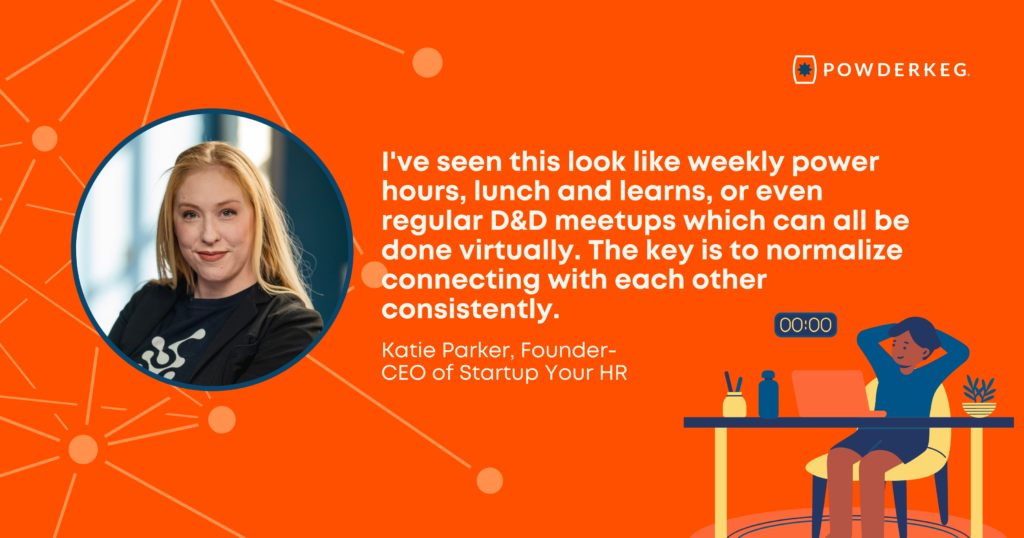How can you build a company culture remotely?
Before remote jobs became commonplace in the tech community, we may have taken for granted the ease of building and maintaining corporate culture, company values, and workplace culture when we were all in the office together, naturally interacting with our colleagues in-person every day. But that everyday camaraderie is a bit harder to replicate with remote jobs and remote-first workplaces.
There are still ways to build a company culture in remote work despite the distance, especially with the advent of new tech and social apps. That’s why we asked 20 tech leaders for company culture examples on the impact of remote working on company culture. They provided the following tips for culture building strategy and building company culture in a remote work environment. Follow these tips to learn how to build company culture, how to build a remote team, and learn more about what is company culture at a remote startup.

Here are 20 actionable tips from leaders at companies with remote work culture that you can use while building team culture remotely:
- Spent More Time Together to Build Remote Culture
- Define What Great Work Looks Like with Goals and Standards
- Show Up with Humility, Equity, and Authenticity
- Reach Out and Build Relationships
- Turn On Your Camera
- Use the 3 A’s to Build a Resilient Remote Culture
- Employ Active Listening With Your Team
- Hold Regular, No-Agenda and Optional Meetings
- Engage With Colleagues Through Events
- Set up Virtual Happy Hours and Coffee Breaks
- Communicate Clear-Set Goals and Standards
- Intentionally Create Moments of Fun
- Use a Slack Bot to Spark Conversation
- Put Business Values and Company Culture First
- Normalize Employee Connections Consistently
- Build Strong Connections With the Employees You Lead
- Encourage Accountability by Restricting Micromanagement
- Respect Out-of-Work Responsibilities
- Create Moments to Meaningfully Connect
- Build Genuine Relationships and Human Connections
Spent More Time Together
I believe the most important factor in a strong and healthy remote culture is the same as in an in-person one: time together. It’s difficult to get time with individuals and even more difficult to have the entire team in the same room when remote, but it’s absolutely critical to do so as often as possible.
Mitch Causey, CEO, Demandwell
Define What Great Work Looks Like with Goals and Standards
Choosing a hybrid or remote workstyle and being flexible in our work doesn’t have to mean we are allowing everybody to dictate and rule their own work schedules. Organizations can still keep to their goals and cultural standards. Once we define what great work looks like, we can give the freedom for people to work where (and when) they want to.
Stephanie Murphy, Leadership Consultant, ADVISA
Show Up with Humility, Equity, and Authenticity
Building company culture with a distributed workforce starts with regularly taking time to create a space where everyone feels safe and comfortable contributing to conversations as much or as little as they are willing, without fear of judgment. When everyone–including leaders–shows up with humility, interest, equity, authenticity, and fallibility, it strengthens trust and mutual respect. This foundation makes adopting a “one team” attitude easier. When teams are aligned and know they’re “in it” together, an environment of support that’s free from blame develops. Everyone rises together, and everyone catches each other together if there’s a stumble
Dawn Lego, Director of Brand Engagement and Channel Marketing, Onecause
Reach Out and Build Relationships
If you are sitting next to a team member in the office every day, it won’t take long to start learning about them; without even trying, you start getting a sense of who they are as a person, family life, hobbies. Find ways to reach out to team members outside of the office dialog. I’ve found that I tend to work better with people I know and like.
Alden Miller, Storyteller, Alchemy
Turn On Your Camera
Do not underestimate the power of body language and visual cues. There is no replacement for facetime with teammates. We believe so strongly in this that it’s a requirement that all employees turn on their video during meetings – with a few exceptions.
Jake Miller, CEO, Engineered Innovation Group
Use the 3 A’s to Build a Resilient Remote Culture
Building a resilient remote company culture starts with keeping your workforce human, engaged and agile. Unnecessary meetings certainly aren’t unique to remote work, but it can be tempting to schedule a quick call for every little task. And as everyone knows, these “quick calls” can often turn into bigger meetings. Create agendas for meetings and ensure you stick to them. Give everyone a chance to speak but keep the pace going with time limits for particular subjects.
Above all, it’s important to remember that you won’t get it right straight away. Request anonymous feedback from everyone once a month. Ultimately it’s about following the “3-A model”: Ask your team what you think could be improved, analyze performance and responses, and act to make your changes and adjust over time.
Benjamin Graham, Content Strategist, AnswerConnect
Employ Active Listening With Your Team
Building a great company culture is very hard, especially if it’s 100% remote because people are behind a computer from wherever they choose to be. Destroying a company’s culture is very easy. The best way to build something that is worth it, is by being 100% inclusive and being able to actively listen to your team. People have different points of view and being able to listen to and include them is what makes a company truly special. If you are able to bring people from different backgrounds together then you are indeed building a culture worth sharing.
Pablo Paz, CEO and Founder, Interactive Contact Center
Hold Regular, No-Agenda and Optional Meetings
The number one recommendation I have for building a great company culture in a remote workplace is holding regular meetings with no agenda for the sole purpose of connecting with teammates. We do this a couple of times every week at Compt and it has been a fantastic opportunity to get to know everyone on a more personal, meaningful level, which builds a sense of camaraderie that’s so important in a fully remote startup.
On Monday mornings we have an optional-to-attend coffee chat where we can talk about our weekends, laugh about things happening in our personal lives, or discuss anything else you typically would at the office water cooler. On Wednesday afternoons we have a Zoom meeting set aside to play games (also optional). During this time we get competitive, have fun, and release some mid-week stress. Both meetings have afforded us the opportunity to build connections across departments we may not otherwise have.
Joe Alim, Head of Product and Customer Experience, Compt
Engage With Colleagues Through Events
I personally think that being remote is great. You get time for yourself, for your family and you don’t have to go through a daily commute to the office. But what you miss out is engagement with your colleagues, with your managers, leaders and friends. So, it’s important that companies with remote-first culture must plan employee engagement initiatives.
This can present as regular monthly offsite events, rolling out workation once a quarter, or holding virtual and in-person hackathons. Employee engagement and bonding is extremely underrated. And it should be the priority of any organization that’s willing to be remote-first.
Muhammad Saad Khan, Associate Vice President Marketing, Cloudways
Set up Virtual Happy Hours and Coffee Breaks
Maintaining a strong company culture can be challenging in any workplace, but it can be especially difficult in a remote environment. One way to overcome this challenge is to make sure that everyone feels like they are part of the team. This means regular check-ins with employees, encouraging collaboration and sharing of ideas, and promoting a sense of belonging. It can also be helpful to create opportunities for social interaction, such as virtual happy hours or coffee breaks. By making company culture a priority, you can help to ensure that your remote workplace is a thriving and supportive environment.
Travis Lindemoen, Managing Director, nexus IT group
Communicate Clear-Set Goals and Standards
The distance between coworkers seems to cause certain problems. But there are a ton of ways to deal with them. My personal tip for building company culture in a remote workplace is most certainly to encourage employees to see and apply the vision behind the company.
Clear-set goals and standards, as well as systems that allow the employees to self-regulate to a degree and easily find solutions to their problems. And that’s what I tirelessly try to instill in the people I work with. Regardless of what the vision for your company is, it’s important that all individuals that make up the work collective within their workspace see the same vision and aspire to make that vision a reality.
Dejan Kvrgic, Founder, ProContent Services
Intentionally Create Moments of Fun
Don’t forget to create opportunities where your team can have fun together. Your vision, mission, and values should be what define and drive your remote company culture, but you also need “moments of fun” where your team can get together, laugh, joke around, and get to know one another on a deeper level.
Think about happy hours that you’d have when working in an office together. You need to recreate those in a remote setting so that you gain the same cultural benefits from them. If you fail to incorporate these “moments of fun”, your culture will feel stuffy, people won’t get to know one another as closely, and it’ll impact overall morale over time.
Connor Gillivan, Owner and CMO, EcomBalance
Use a Slack Bot to Spark Conversation
It’s hard to make up for the watercooler talk and casual friendly updates in the workplace when you’re limited to Zoom and Slack. That’s why I love Slack bots like S’Up that randomly pairs team members for casual video calls. It’ll give you prompts like “which superhero would you be and why” or “what’s something you’re looking forward to in the next few months” to spark conversation and help facilitate friendly interactions.
Corey Haines, Founder, SwipeWell

Put Business Values and Company Culture First
Company culture is a way of life, the safety net for any business. You have your goals in front of you, but you have the culture to back you up from behind. It’s the invisible force that can sustain or ruin your future. Core values and rituals need to be implemented from day one, and every new employee should match those values. Never hire for skills alone without having that similar vibe to share with the future employee. Think in terms of tribes. It’ll be much more difficult to align or fire someone who doesn’t embrace your values and way of being. Business is a significant part of life. Make it worthwhile and evaluate people holistically.
Cristina Imre, Executive Coach & Mentor for Founders, Quantum Wins
Normalize Employee Connections Consistently
In order to build a positive company culture in a remote setting, employees need regular and consistent times to connect. Company values are built and sustained through action and connection, which don’t happen in a vacuum. I’ve seen this look like weekly power hours, lunch and learns, or even regular D&D meetups which can all be done virtually. The key is to normalize connecting with each other consistently.
Katie Parker, Founder-CEO, Startup Your HR

Build Strong Connections With the Employees You Lead
Building connections with employees when leading your remote teams provides the glue needed to strengthen work culture performance. From a TIGERS 6 Principles perspective it improves trust, interdependence, genuineness, empathy, risk resolution and success in the workplace. Getting to know your employees streamlines tasks, improves delegation, and provides you the inroads to develop employees.
When you combine this with online opportunities that introduce remote workers to one another you create new rituals and ceremonies that strengthen the beliefs and norms that make up your culture—not replace them. This ultimately means filling your employee pipeline with online activities such as learning circles where employees learn and practice training you provide them. This produces a cooperative work environment and the type of manager to co-worker relationships that feel like a tight knit family focused on helping one another and boosting employee wellbeing.
Dianne Crampton, President, TIGERS Success Series
Encourage Accountability by Restricting Micromanagement
Remote working is more than just letting your team work from anywhere, at any time. If you really want to go beyond flexibility, you need to build a culture where working in silos yet collaborating with one another proactively is something everyone is accountable for. The one tip that has helped our remote marketing agency efficiently deliver work across projects, is that the team is well aware of their responsibilities and the tasks in the first week of the month.
We then make use of project management tools and Slack for communicating our sprint with the others in the team. Watching one another set realistic daily sprints also serves as a great motivation for low days; and when we do unrealistic sprints, we reach out to one another to talk about workloads. This little practice has helped us remove micromanagement by almost 90% already.
Vanhishikha Bhargava, Founder, Contensify

Respect Out-of-Work Responsibilities
Leaders need to understand that people have responsibilities outside the workplace. This is not about Work/Life balance where you pay faux respect to the notion that people have lives and interests outside work. This is understanding that their responsibilities outside work—caring for elderly parents, taking care of children, being involved in community groups, and anything else—are important elements of team members’ lives.
Respect these responsibilities. Enable them to live up to and meet these obligations. And they’ll reward you with enhanced performance in the workplace, greater employee engagement, and higher results.
Steven Howard, Leadership Mentor and Author, Caliente Leadership
Create Moments to Meaningfully Connect
I’ve supported tech organizations for several years now as a Talent Development & Workplace Experience Consultant and the companies that do it best create intentional spaces and moments for connection and fun. Whether it’s a Slack channel for banter or skill sharing or weekly virtual lunches—organizations that thrive that focus on creating cohesion and cross-department collaboration. Strong relationships are central to successful organizations.
So, the very best cultures also nurture an environment that believes in two-way feedback, consistent 1:1s and offering opportunities for growth and development—in addition to the fun stuff. Great cultures aren’t accidental, they are fostered by all levels of the organization and created with the goal in mind of building connections, competencies and elevating communication.
Elizabeth Boyd, Talent Development & Learning | Workplace Experience Consultant, TalentLab.Live
Build Genuine Relationships and Human Connections
Building company culture in a remote workplace should come from the heart. People are the heart. They’re the core. Never lose sight of that. This is true, of course, in every type of company but especially important in a remote workplace. As much as our remote team loves having the flexibility and freedom of a remote work life, we all need human connection from time to time.
Build genuine relationships through online chats, share life stories, and ask others to do the same. Share updates from your life, host virtual events (sparingly), and most of all—never make people feel like anything is mandatory or an obligation. Allow people to genuinely come to you and share with the team when they want to. Post funny gifs, remember birthdays and anniversaries, and make people laugh whenever you can. Have someone responsible for this type of engagement.
Jackie Leavitt, Editor In Chief, Cloudwards
—–
Follow these tips for building company culture in a remote work environment, and you can build a remote culture where your team members can thrive.
Ready to explore remote jobs at startups and tech companies in the Powderkeg community? Look for companies in hot industries with room to grow. Take the time to research each company by reviewing their company profile. Login to Powderkeg to request an introduction to the hiring manager.
If you are interested in exploring remote companies in the Powderkeg community, check out our curated list of The Best Tech Companies to Work for Remote Jobs in areas beyond Silicon Valley.
You can browse all of Powderkeg’s Best Tech Companies to Work for, follow them for insights, or request an introduction to plug into your next big opportunity.
Want to get connected with the leaders in the Powderkeg community?
Are you interested in joining the only private membership network focused on supporting tech companies and executives in communities beyond Silicon Valley. Apply for Powderkeg Premium Membership today.
